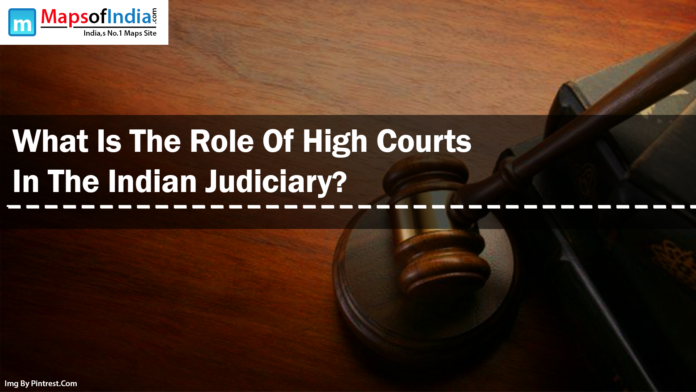As the highest court in the nation, the High Court is responsible for interpreting laws, defending fundamental rights, and ensuring that the rule of law is upheld across its territory. All states and union territories are under the High Court’s jurisdiction, the highest court in India, not higher than the Supreme Court. It was established as a cornerstone of the Indian Constitution’s goal of creating a unified legal system.
About High Court
As part of India’s constitutionally mandated system of interconnected courts, the High Court is the highest in each state’s judicial administration. Moreover, if we see historically, the idea of the High Courts has been:
- The state’s ultimate appellate court
- The one who ensures fundamental freedom
- Guardian of India’s Constitution
- The Indian Constitution interpreter
About Indian Judiciary
A three-tiered, single-integrated judicial system was enacted by the Indian Constitution in 1935, drawing inspiration from the Government of India Act:
- The Supreme Court
- The High Courts
- Other Lower Courts and Subordinate Courts (District Courts)
The nation’s federal and state laws are both upheld by this unified judicial system.
High Courts in Indian Judiciary
The Constitution of our country gives the Supreme Court and the High Courts very important jobs to do. In addition to regular criminal, civil, and special law cases, these courts are also responsible for reading the Constitution and making important decisions for the public. Additionally, citizens can seek judicial intervention if they believe a state action that negatively impacts them violates the Constitution or statute. The different types of cases these courts hear, the importance of constitutional issues (some with enormous political repercussions), and the duty to protect people’s rights from possible violations all call for judges of the highest quality who know the law and the Constitution inside and out and are known for being fair and honest.
To that end, it is crucial to carefully select qualified individuals to serve as judges during the initial appointment process. Sometimes, people have said that the selection was wrong and that hidden agendas were at play. There are also claims that the executive branch influences the appointment of judges. When there was a strong call for appointing individuals who could be called “committed Judges” at one point in our history, official spokespeople were also present. In addition, chief justices and prime ministers have both been the targets of accusations of favouritism.
Role of High Courts in Indian Judiciary
The High Court is the highest court of appeal in a state where the Constitution needs to be interpreted. It safeguards citizens’ fundamental rights. Additionally, it performs consultative and supervisory roles. Let us discuss them in detail:
Original Jurisdiction
In these types of cases, the applicant can go straight to the High Court instead of filing an appeal. Cases involving the State Legislative Assembly, marriages, the enforcement of basic rights, and transfers from other courts are most likely to fall under its purview.
Authority to Supervise
Only the High Court has this unique power to oversee lower courts; no other court has it. The High Court can dictate record-keeping procedures to its lower courts and offices. It can also decide how much money sheriffs, police officers, and lawyers get paid and set standards for how those courts work.
Court of Record
The process entails documenting the decisions, actions, and proceedings of Supreme Courts for the benefit of future generations. No court can question these documents any further. It can punish itself when it disobeys its own rules.
Authority over Lower Courts
The jurisdiction over supervision and appeals has been expanded in this way. As stated in the statute, the High Court can remove a case from any lower court if it concerns a major legal issue. You can either end the case or settle the legal question and bring it back to the same court.
Jurisdiction for Hearing Appeals
This process will occur when an individual files a formal request to review a decision made by a lower court in that jurisdiction. Two subsets exist within this power:
- Orders and judgements of the District Court, Civil District Court, and Subordinate Court are all included in the term “civil jurisdiction.”
- Criminal jurisdiction encompasses decisions and orders made by the Sessions Court and the Additional Sessions Court.
Judgement Review Power
The authority to review the legality of federal and state executive orders and laws is part of the High Court’s purview. However, the term “judicial review” does not appear anywhere in our Constitution. But, the High Court does have this authority according to Articles 13 and 226.
Advisory authority
The high court has the authority to hear and decide on issues presented to it as advisory jurisdiction by any branch of government, legislature, or governor with the proper structures in place.
Writ Jurisdiction of the High Court
Under Article 226 of the Constitution, a high court has the authority to issue various writs, such as habeas corpus, mandamus, certiorari, prohibition, and quo warranto. These writs enforce citizens’ fundamental rights and serve any other purpose that may arise.
Enforceability of Judicial Precedents
Since India is a common law nation, decisions made by higher courts, such as the Supreme Court and High Courts, are binding on lower and subordinate courts. In India, precedents have a significant role in law. Here is the hierarchy of courts and its binding value:
- All lower courts in India must adhere to the “Supreme Court’s” rulings. Decisions made by Lower and high Courts or other judicial authorities are not binding on the Supreme Court.
- As long as they do not contradict Supreme Court decisions, decisions of a “High Court” are binding on all lesser courts within its jurisdiction. However, a High Court’s decisions only have persuasive value for courts outside of its jurisdiction. Referral to a higher bench occurs when decisions of the High Court disagree with those of a comparable court.
- Decisions made by higher courts within a state are binding on “lower courts”. It is only possible to get persuasive value from decisions by High Courts in other states.
Conclusion
At the very top of the State’s judicial administration ladder is the High Court, which personifies liberty, impartiality, and supremacy under the Constitution. Its wide-ranging authority guarantees the rule of law. Furthermore, it protects the fundamental freedoms and rights of those living in the relevant state. In the ever-changing Indian legal landscape, the High Court will be essential in determining the country’s future.
FAQs
Where does the High Court of India get its authority in the Indian Constitution?
The provisions of the High Courts are in Articles 214 to 231 of Part VI of the Indian Constitution.
Who picks the judges for the High Court?
The President of India selects the judges of the High Court in consultation with the State Governor, the Chief Justice of India, and the Chief Justice of the relevant High Court.
Who selects the High Court’s Chief Justice?
The president of India chooses judges of the High Court.
India has how many High Courts?
The nation has twenty-five High Courts. The Union Territories of Jammu and Kashmir, Ladakh, and Delhi each have their own High Courts.
Which is India’s oldest High Court?
One of India’s oldest high courts, the Calcutta High Court, opened its doors to the public in 1862.




